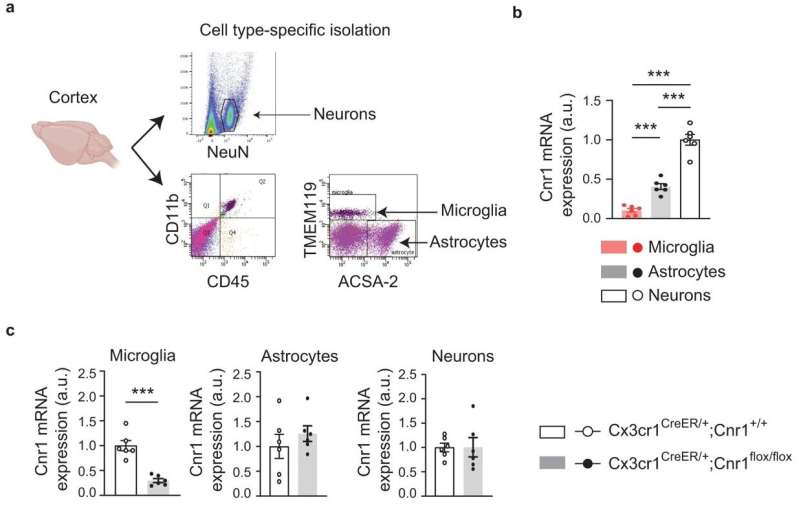This article has been reviewed according to Science X's editorial process and policies. Editors have highlighted the following attributes while ensuring the content's credibility:
fact-checked
peer-reviewed publication
trusted source
proofread
Study suggests marijuana use damages brain immune cells vital to adolescent development

In a mouse study designed to explore the impact of marijuana's major psychoactive compound, THC, on teenage brains, Johns Hopkins Medicine researchers say they found changes to the structure of microglia, which are specialized brain immune cells, that may worsen a genetic predisposition to schizophrenia.
The findings, published Oct. 25 in Nature Communications, add to growing evidence of risk to brain development in adolescents who smoke or eat marijuana products.
"Recreational and medical marijuana use is rapidly expanding in the United States and abroad, and teens are especially vulnerable to long-term negative effects of THC," says Atsushi Kamiya, M.D., Ph.D., professor of psychiatry and behavioral sciences at the Johns Hopkins University School of Medicine. "We know THC is psychoactive, and its concentration in marijuana plants has increased four times in the last 20 years, posing a particular danger for adolescents who are genetically predisposed to psychoactive disorders including schizophrenia."
Microglial cells are a specialized subset of immune cells called brain-resident macrophages that are found in the central nervous system. They play a direct role in neuron-to-neuron communication, immune response and healthy brain development. In adolescence, microglial cells play a critical role in brain maturation related to social and cognitive function by synapse pruning and secreting of chemical transmitters.
Structural changes that interfere with them, the Johns Hopkins investigators suspected, may alter the brain's wiring and messaging system in the still developing brains of teens.
To test their idea, researchers used genetically engineered mice with a mutation that mimics a genetic risk for psychiatric disorders in humans, along with normal mice as a comparison group. The mice carrying the mutation show changes to the brain with or without THC, specifically to the areas responsible for emotion, learning and memory.
During mouse adolescence, animals from both the genetically altered and normal groups were treated either with daily single injections of THC or with benign saline solution. After 30 days of injections, the mice were given three weeks of rest before behavioral tests were performed to assess their psychosocial development.
The tests included those involving odor sensing, object recognition, social interaction and memory. The researchers also used fluorescent staining to measure the number and morphology of microglial cells in the animals' brains.
Results showed that mice exposed to THC had increased microglial apoptosis (programmed cell death), and the reduction in the number of microglia in mice with the genetic mutation and THC was 33% higher than in the normal mice with THC. Microglial reduction was particularly present in the brain's prefrontal cortex, which is responsible in both mice and people for memory, social behavior, decision making and other executive functions.
Because microglia are involved in brain neuronal maturation, a decrease in healthy ones may result in higher instances of abnormal cell signaling and communication, the researchers say. The genetically altered mice given THC in the study scored 40% lower on social memory than their counterparts given saline.
"This kind of study is critical right now because marijuana is becoming more mainstream, and we are just beginning to understand how it affects the brain immune cells," says Yuto Hasegawa, Ph.D., research associate of psychiatry and behavioral sciences at the Johns Hopkins University School of Medicine and the study's leading author.
Kamiya cautions that study results from genetically engineered mice cannot be applied directly to what happens in a human brain. But "studies in animals suggest there may be long lasting and negative effects of marijuana use during adolescence," Kamiya says.
"More research is needed, but we strongly advise caution in marijuana use by teenagers," Kamiya adds.
Researchers say the next step for these studies is to pinpoint exactly how microglial abnormality affects neuron function at the molecular level. From a clinical perspective, they hope to use these findings to explore how marijuana exposure contributes to schizophrenia and other psychiatric disorders.
More information: Yuto Hasegawa et al, Microglial cannabinoid receptor type 1 mediates social memory deficits in mice produced by adolescent THC exposure and 16p11.2 duplication, Nature Communications (2023). DOI: 10.1038/s41467-023-42276-5




















